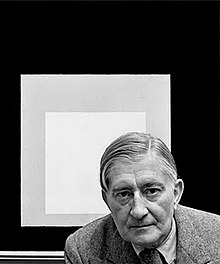Josef Albers
| Josef Albers | |
|---|---|
 |
|
| Born |
March 19, 1888 Bottrop, Westphalia, Germany |
| Died | March 25, 1976 (aged 88) New Haven, Connecticut |
| Nationality | German-American |
| Education | Königliche Bayerische Akademie der Bildenden Kunst |
| Known for | Abstract painting, study of color |
| Movement | Geometric abstraction |
Josef Albers (/ˈælbərz, ˈɑːl-/; German: [ˈalbɐs]; March 25, 1888 – March 25, 1976) was a German-born American artist and educator whose work, both in Europe and in the United States, formed the basis of some of the most influential and far-reaching art education programs of the twentieth century.
Albers was born into a Roman Catholic family of craftsmen in Bottrop, Westphalia, Germany. He worked from 1908 to 1913 as a schoolteacher in his home town; he also trained as an art teacher at Königliche Kunstschule in Berlin, Germany, from 1913 to 1915. From 1916 to 1919 he began his work as a printmaker at the Kunstgewerbschule in Essen. In 1918 he received his first public commission, Rosa mystica ora pro nobis, a stained-glass window for a church in Essen. In 1919 he went to Munich, Germany, to study at the Königliche Bayerische Akademie der Bildenden Kunst, where he was a pupil of Max Doerner and Franz Stuck.
Albers enrolled as a student in the preliminary course (Vorkurs) of Johannes Itten at the Weimar Bauhaus in 1920. Although Albers had studied painting, it was as a maker of stained glass that he joined the faculty of the Bauhaus in 1922, approaching his chosen medium as a component of architecture and as a stand-alone art form. The director and founder of the Bauhaus, Walter Gropius, asked him in 1923 to teach in the preliminary course ‘Werklehre' of the department of design to introduce newcomers to the principles of handicrafts, because Albers came from that background and had appropriate practice and knowledge.
...
Wikipedia
